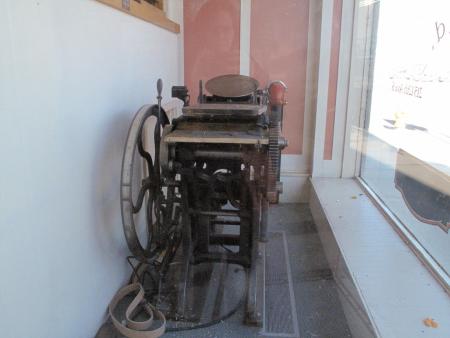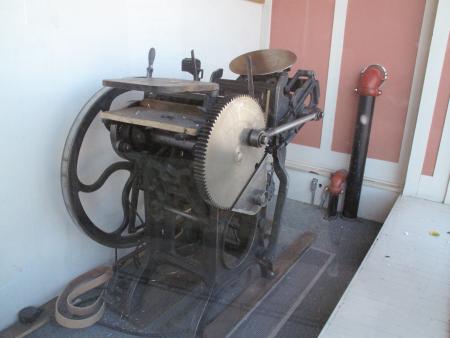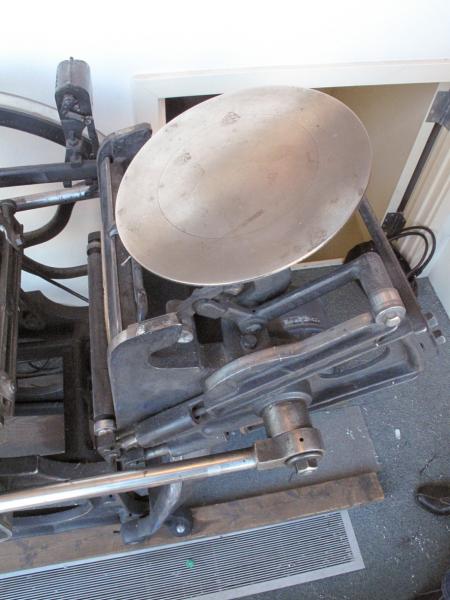Moving a press?
Hello,
We are encountering a dilemma trying to move a Chandler & Price oldstyle press. It is being donated to our school from a public library. Currently it is in a front window display case (see photos), and we thought the glass could just be removed. However, turns out it’s old glass, single pane, not tempered and some glass folks we asked are not interested in moving it, too dangerous.
There is a tiny door to get into the cabinet, so we’d have to disassembled the press {if this is even possible, and I’m sure the wheel will not fit}, or remove the entire wall and replace it when finished.
We are then trying to move it down a ramp into our basement. Any tips are helpful as I’ve never moved a press. Has anyone had luck hiring someone to do something like this?
Thanks!

chandlerpress-1.jpg

chandlerpress-2.jpg

chandlerpress-3.jpg

chandlerpress-4.jpg
This is not a press suitable for use in a school.
Where are you located? If you’re near Kansas City I’m able to help out.
Where are you located? I was a glazier for many years (glass guy). How big is the glass?
Nampa, Idaho is where I’m located. Thanks
Benjonesprintmaker, not near Kansas City.
Docs Coffee, the glass window is large, 105”by 99”
and to The Arm NYC, I admit I’m not a pro, still learning, but why is this not a press suitable for use in a school?
thanks for the help.
Since you did not say what sort of school the press was donated to, the assumption is that it may be an elementary or secondary school, where the students are not experienced with printing machinery. The press can be quite dangerous for inexperienced people.
As to moving it, I suggest you measure the small door to be sure the parts can not fit through it, and then consider enlarging the door to make it possible to remove the press that way. The main problem will not be the flywheel, but the frame, though that can be broken down into fairly small parts if necessary. However, dismantling the press in that confined space will not be easy, as the first step would be to remove the flywheel shaft, which would require rotating the press on its feet 90 degrees. It is hard to tell but it appears to be a 10x15 press, on which the bed itself weighs about 200 or more lbs, so removing that will require mechanical help. It is not a project for a person who has not moved a C&P before. There are a couple of people in Idaho who might be able to advise you first hand.
Bob
A hand-fed platen press such as this is not suitable for use in any school or business except for one where it is owner-operated only. Having this press in use in a school of any kind in the US is a clear and flagrant OSHA violation punishable by a hefty fine. It is also my understanding that, given its illegal nature, an accident on such a press would not have to be covered by whatever liability policy the school might maintain.
I would suggest you seek a tabletop hand lever platen press and/or a hand cranked cylinder proof press.
I want to make it clear that this is in my opinion still a great press, but if you want to save it, you should take it home.
@jtucker
I’m in sunny Los Angeles. If I was closer I’d give you a hand. :-(
And I agree with the other post about OSHA violations. As I understand it, at least with Cal-OSHA, only the owner of this type of press is allowed to run it. I would strongly suggest you don’t use it as a teaching tool, as The Arm NYC rightly suggests. Don’t take the chance, it’s not worth it even though it’s a great press.
A) As stated above, this is Not a teaching tool. demonstration and display maybe…. Even with the laws,,, Good luck finding insurance to cover you, letting someone else run this thing. it may be cute, it certainly looks operational, but,,, this press will crush Any part of the human body without much an effort. this is for the owner only.
B) moving this press,,,Seeing as how the flywheel won’t fit through that door, you are limited to the glass or the wall. All 3 three shafts need to come out to disassemble this press: 1) the main shaft; 2) the crankshaft; 3) the bed shaft. the space there looks pretty tight for this to happen.
Glass Removed: An experienced tow truck operator, could reach in there and lift the press out no problem. A single pane glass this big?? it is time to upgrade anyways. got to be killing the heat bill. I can’t believe there isn’t someone who could pull that glass out in one piece. maybe some vandals could come solve that. kidding….maybe go in together on glass upgrade.
Wall Removed: whatever is there needs to be removed then put back? maybe leave the wall out once the press is gone? still need to get it out of the building. go with the glass.
Sliding it down a ramp to lower level. A) is the ramp strong enough to hold weight of press and likely 1-2 movers.
B) is equipment available to make sure it does not Fall down the ramp? Is there structure at the new building to attach moving equipment to? How to move press around once it is on lower level?
I would consider lifting press out through front (glass side) then after moving to location on a trailer, disassemble to go down to lower level for reassembly.
You have a lot of issues here and if, as you say,, you have never dealt with heavy equipment, centers of gravity, how they change, the equipment involved, and how leverages are applied, i would seriously consider hiring people who have this experience, “Successfully”. i am in Milwaukee, wis. and for expenses i would come out to run this project. but, i am sure you could find someone closer. Search “machinery movers”. if things go wrong here, they can go Very wrong. Proper planing with ample expertise will in the long run, yield the best results.
Good Luck!
Thanks for all the advice. This is a university and we do already have 2 proof presses in our Letterpress studio, had planned to remove the motor and just use the flywheel.
This press was used for our local newspaper in a business setting.
I will rethink it as you all have suggested, I certainly don’t want to violate OSHA laws.
I agree, removing the glass would be easier, perhaps I’ll ask another company.
Thanks again for commenting and providing feedback.
Check with your university safety people, we did and though they had qualms, they were satisfied to everyone’s satisfaction.
I’d look more closely at the issue if OSHA applies to an educational setting. Again, someone at the University will be qualified to answer definitively. We disconnected motors and replaced them with treadles and conduct a thorough training on the use and dangers of the press and closely supervise press use.
Thanks Arie, that helps. I have been in contact with another university in the area and they have a Golding jobber and did just that, replaced the motor with treadles and train people who use it. It obviously is dangerous, but we have a woodshop with a table saw and many other potentially dangerous machinery.
As I understand it, if the person who trains the students on the press is paid by the school, you are already in violation of the OSHA regs, treadle or none. I am going to stop lecturing about this now, but I would suggest you do some serious research in making sure your shop is safe and compliant as one accident or OSHA penalty can threaten the whole print studio, compliant presses and all.
If you want me to, I could post a picture of the person who taught me to work on a treadle platen press (not powered by a motor!). He misfed a sheet, went for it and lost his entire index finger! He was an experienced printer! His insurance company wouldn’t pay him, because there was no security on the press. I don’t want to lecture you either, but treadle platen presses are dangerous…
There have been many threads pertaining to OSHA and platen presses. One thread mentioned that RPMs are figured into the need to install guards on flywheels. However “pinch points” must always be covered. There must be a threshold, no?
Although I am not going to name names here, there are plenty of universities and 501c3 non-profits that have treadle operated platen presses. Some have had guards fabricated.
The person you really want to ask at the school is your university council. Some schools require students to sign a “holds harmless” agreement.
jtucker - How was the press located there in the first place? Someone knows. That is key to knowing how to remove it.
Also - what is the construction of the wall? Seems to me if it is standard frame and sheetrock, the best answer is to cut a hole, roll out the press on pipes and rebuild the hole. Demolition tends to move more quickly than repair so if you’re under a time crunch, move now/repair later is a good choice. The replacement co$t of that gla$$ will get very expen$ive if accidentally dropped, even by a professional. Think: what is the lowest risk option?
I think you should just leave the press where it is
install a treadle
BAM
built in safety enclosure
Then all you have to do is crawl through that tiny door with your ink and paper whenever you want to print, and the library gets to have a ‘free show’ out front
Of course no comment on ventilation once you get to cleanup, but just think, you could store all your tools on that wall next to the press
“But how will I get in the tables”
Ikea makes some wonderful flat pack furniture that I bet could be assembled after going through that little door
I could go on
It’s the perfect aquarium studio
Suction cups on the window with gator clips, holding up freshly printed pieces
“letterpress showcase”
I think Haven Press has the right approach on going through the wall, but it may be that there is a platform on the other side that would preclude the simple procedure of cutting a hole and then rebuilding it. Either direction, through the wall or removing the glass, presents problems, though I would opt for the wall first, depending what may be on the side we can’t see. In retrospect, it was a dumb idea to box that press in to make a display.
If you can move it without taking it apart it’d save you a ton of time. Take your time and use lots of tie-downs and redundant tie-downs. Pallet jack can make it easy if you can get one. Get a Johnson bar to lift it and put pipes under it to roll it along - slow and steady! Bring friends. Don’t drop it whatever you do, they are brittle and once cracked… forget it. It seems daunting but you can move anything if you take your time. If you have to use a ramp to go down stairs it better be a heavy one. Does it have to go in the basement?
As far as the safety tangent - plenty of info out there about how dangerous they are. But they are beautiful machines if used mindfully. I have found that the treadle, as friendly as it sounds, actually requires the press to operate at a fairly high speed for a beginner. If you pump too slow you can’t keep momentum and the press stops or reverses. It’s also a lot to think about if you’ve never done it before - feeding the press standing on one foot (try patting your head too!). We use a motor with a VFD (speed control) for our C&P. We can run super slow - like 6 impressions a minute! Plenty of time for novices to keep their hands out of the way, much safer in my opinion. You can have a treadle too and easily disconnect it when you’re in the mood to go manual (or if the power goes out!).
So all good information, but what happened?
Stin-G - I have the same slow-running VFD on mine, and the other advantage I would point out is that when running slow, the brake on mine really stops the press quickly as well.